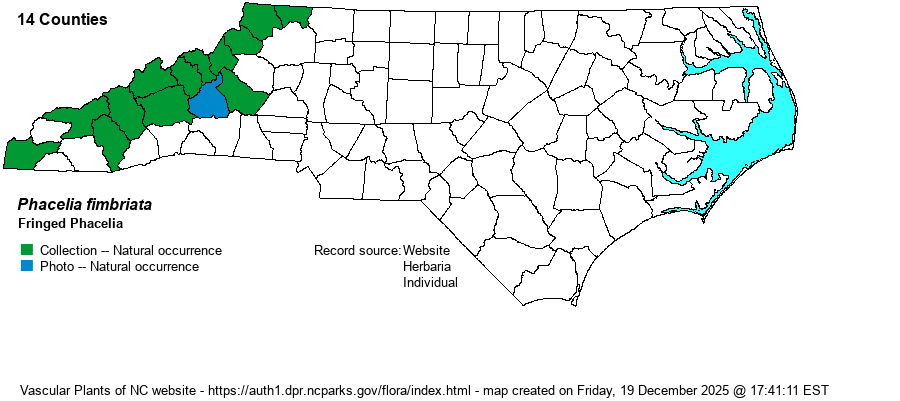| Author | Michaux | |
| Distribution | Occurs over most of the Mountains, though seemingly scarce to absent from the southeastern mountains close to the Blue Ridge Escarpment or the Gorges region; no records yet for Henderson, Transylvania, or Macon counties, and the record(s) for Jackson County is at the far northern edge. Thus, most frequent along the Unicoi Range, Great Smokies, the Amphibolite Mountains, and other ranges along the NC/TN state line.
This is a Southern Appalachian endemic species, found only from southwestern VA southwest to northern GA. | |
| Abundance | Fairly common but local, and where it occurs it can be quite abundant, with many thousands of plants. Despite it being known from barely 20 counties in its range, the Global Rank of G4 seems justified owing to countless millions of plants known for it, many in protected sites. | |
| Habitat | This is a species requiring rich soil, probably more so in high pH soil, but occurring at a great elevation range, from well over 5000 feet at Roan Mountain to well below 2000 feet in the lower reaches of the Great Smoky Mountains National Park. It grows in Rich Cove Forests, along forested streams, in High Elevation Seep Forests, Northern Hardwood Forests, and other rich soil under a deciduous canopy. | |
| Phenology | Blooms in April and May, and fruits shortly after flowering. | |
| Identification | This is a very familiar spring wildflower, owing both to its abundance in large stands and to the delicate look to the flowers. It is a small and weak herb, leaning or sprawling, with branches at the base, and reaching up to 9 inches long. The leaves are alternate and like others in the genus, being cut or dissected into 3-9 lobes, and usually less than 1-inch long. The cymes at the ends of branches each contain a handful of bright white flowers, with rounded petals that have margins deeply fringed; the spread flower is about 1/2-inch across. This species can be so numerous on a forested slope that when in bloom it looks like snow on the forest floor! It can only be confused with the other fringed species, P. purshii. That species has lavender to pink flowers (with a white center), but it is generally larger in overall size (including larger leaves over 1-inch long), and it often grows in rich open areas such as moist fields and roadsides, wet meadows, and disturbed bottomlands. However, P. purshii can occasionally grow inside forest cover, though the flower color should separate these two. | |
| Taxonomic Comments | None
| |
| Other Common Name(s) | Blue Ridge Phacelia | |
| State Rank | S3 | |
| Global Rank | G4 | |
| State Status | | |
| US Status | | |
| USACE-agcp | | |
| USACE-emp | | |

